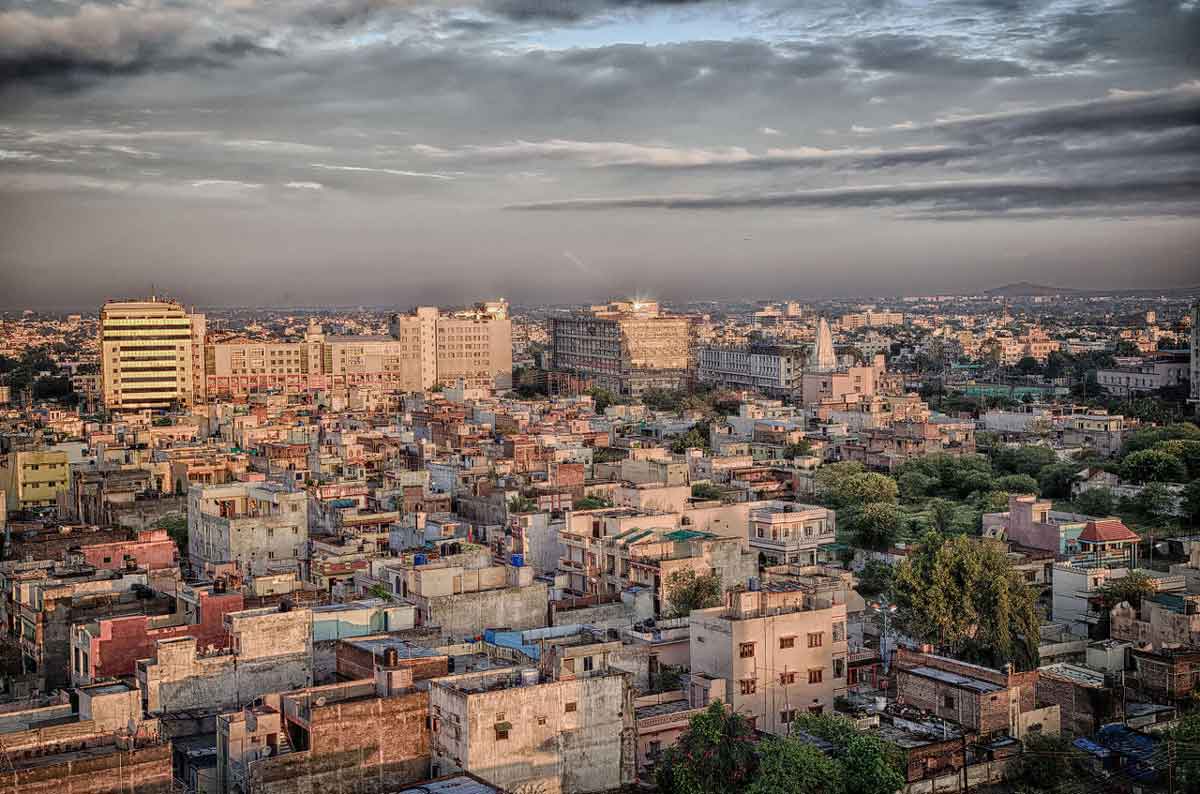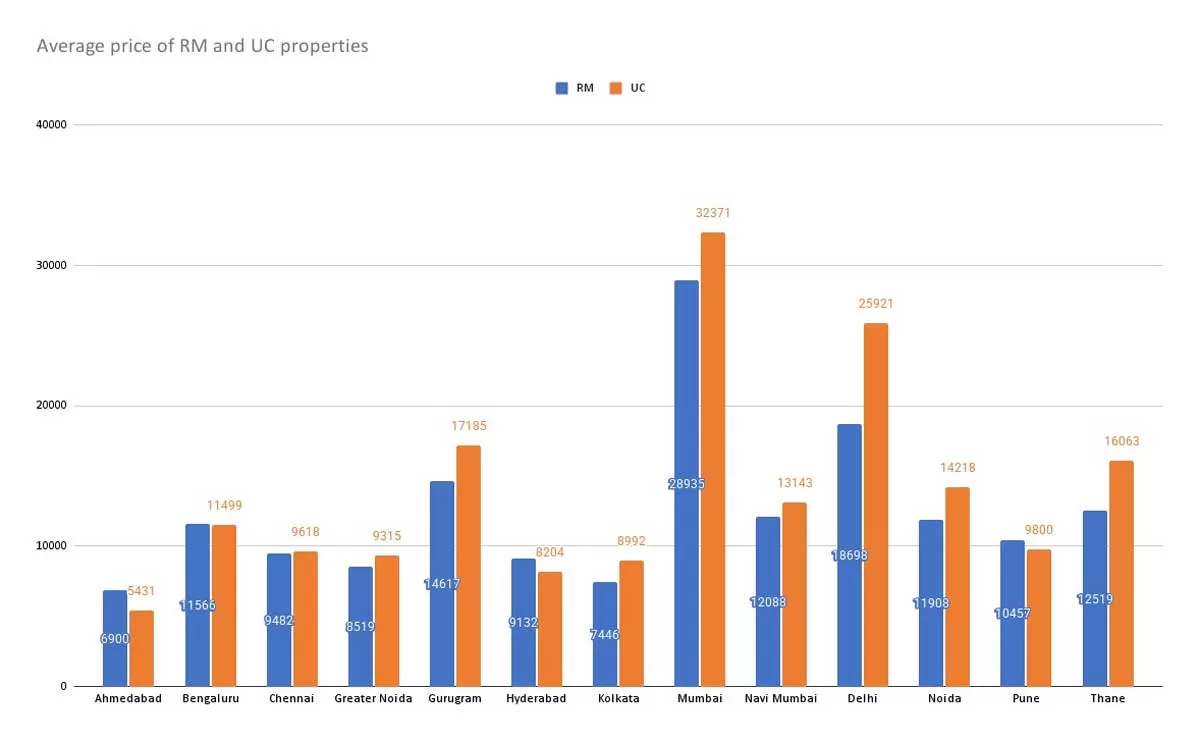- Home
- Real Estate
- The state of the real estate sector in India

The state of the real estate sector in India
Global housing crisis vs. Indian real estate
China's rapid economic expansion was largely because of its housing boom. However, the property market, which accounts for about a quarter of China's GDP, is experiencing delayed growth. The IMF, too, has pointed out that China’s real-estate crisis isn’t over yet. Consequently, it will have a significant impact on the country’s economic growth. Likewise, a number of reports from the West have painted a very gloomy picture for the real-estate sector. As a result, real-estate investors in India are a worried lot. However, it is essential to understand that Indian real estate is not in a precarious situation so far, and much of this gloom and doom is related to how individual governments managed the COVID-19 crisis.“In the US and Europe, the governments doled out a huge quantum of fiscal stimulus,” says Vivek Rathi, Director, Research, Knight Frank (India). “In the US, it was as high as 10 to 12 per cent of the GDP. When it comes to India, even during those times, fiscal stimulus stood at about 1 per cent of GDP. Credit extended to creditworthy borrowers stood at 5 to 10 per cent; the NPA risk the Government was willing to take stood at 2 to 5 per cent. So, when the effect of inflation came into play, inflation levels abroad shot up to from 2 per cent to 9 per cent whereas in India, it touched 8 to 8.5 per cent; this is something we have been exposed to in the past.
As a result, the interest rate hike abroad was phenomenal; from 0.25 per cent to 4.5- 4.75 per cent. Home loan interest rates in the US were hiked from 2.5 per cent to 6 per cent. Moreover, the average loan tenure in the US is 30 years and there is no scope for extension, unlike India. In India, the average loan tenure is 10 years and an extension is given if interest rates are hiked.”
Post covid – 19 even in India interest rates on home loans were hiked but its impact on real estate is not expected to be as severe as witnessed in the global markets. Renu Sud Karnad Managing Director, HDFC Ltd says “A house purchase unlike other products is planned after a lot of due diligence within the family. If the property is liked by the family, is affordable in context of the income and the cost of the house, most people would go ahead and buy the house irrespective of interest rates. It is a single largest decision for any individual and it has an emotional aspect attached to it. A genuine homebuyer who wants to buy a house to live will not hold back just because interest rates have risen. Even though the headline interest rates on home loans start from 8.45 per cent pa onwards, the effective rates on home loans could be just above 5 per cent due to the fiscal benefits available on housing loans. I do not see the rate hike reducing demand for housing. For most existing home loan borrowers, the EMIs will not increase and the higher rates will be adjusted by extending the tenure wherever possible unless the customer wants to increase his EMI. Since home loans are long-term and interest rates will increase and reduce as well over this long tenure , the rates usually even out over the term of the loan. Only a fraction of cases may require readjustment of EMIs.”
The big tech layoffs
To a certain degree, the astuteness of Indian authorities in mitigating the COVID-19 crisis has the real-estate sector insulated from the global housing crisis. However, the ongoing cycle of layoffs by big tech companies is posing another challenge for the real-estate sector. A good deal of commercial and residential spaces in cities like Bengaluru, Pune, Hyderabad and Chennai cater to the IT sector. Having said that, according to a report Decoding jobs 2023 prepared by Gurugram based digital recruitment platform Taggd in collaboration with CII “The hiring in IT sector is expected to grow at a muted rate of 10 per cent. However, demand for tech talent will rise in conventionally non-tech industries like manufacturing, agriculture, and pharmaceuticals.” So, is there a reason to worry?“One of the major challenges will be handling the fallout from reduced income flows in the IT/ITES sector,” says Saket Mohta, Managing Director, Merlin Group. “As it makes up a sizable chunk, we expect it to be a major challenge in cities like Pune and Bengaluru. However, this is not to say that the entire demand in the market will take a huge hit. The real-estate market will do well in 2023 as we can already see that the economy will be robust, local activity will resume and the Government will take necessary measures.”
“The Indian real-estate market has successfully cemented its position among the top 10 realty sectors in the world,” asserts Abhishek Kapoor, CEO, Puravankara. “According to the India Brand Equity Foundation (IBEF), it is expected that the industry will reach a size of $ 1 trillion by 2030 and will contribute 13 per cent of India’s GDP by 2025. Last year, housing sales in India witnessed a record high of 3.65 lakh units across the top seven cities. Institutional investments in retail real estate also jumped to $ 492 million in 2022. As part of the Budget, there have been several large announcements, including the Rs 79,000 crore allotment to PMAY. While internationally there have been layoffs in some companies, when viewed as a part of the whole IT/ITeS sector, they are not significant in India. In 2021, we had a total of 4.5 million employees in these sectors, a number which further grew last year. Over a period of time, the emergence of manufacturing, investments in infrastructure, government spending and increasing private investment cycle and economic activity will lead to a more stable job market and demand will continue to grow.”
In agreement, Rakesh Reddy, Director, Aparna Constructions and Estates, adds, “Despite instances of global economic volatility, India’s real-estate sector has continuously demonstrated its resilience. While it is unfortunate that the IT industry is facing financial headwinds leading to mass layoffs, this has so far been seen mostly in the developed markets. The domestic IT market has been resilient with layoffs confined mostly to a few startups. This will not have a significant impact on the real-estate sector in India.”
Impact on real estate in Tier 2 and 3 cities
“It is understandable to be concerned about the potential impact of tech layoffs on real-estate projects in Tier 2 and 3 cities, where a sizable portion of the IT workforce resides,” observes Kaushal Agarwal, Chairman, The Guardians Real Estate Advisory. “A slowdown in the IT sector can lead to lower demand for housing, which can have a negative impact on the local real-estate market. However, it is important to remember that real-estate markets are influenced by a variety of factors and can vary greatly from one location to the next. While the situation in some areas may be difficult, it may not be necessary to ‘run for cover’. Instead, it is best to carefully consider the specific market conditions and seek professional advice before making any major decisions. It is also worth noting that while the current situation is difficult, the real-estate market can be cyclical and there may be opportunities for recovery in the future.”
Meanwhile, Reddy is quick to suggest that the prevailing circumstances may, in fact, give rise to opportunities for developers in Tier 2 and 3 cities. “The commercial real-estate sector in India has seen sustained growth due to an expanding workforce and decentralisation of commercial hubs, which are no longer limited to metros. Moreover, with the proliferation of remote working and the emergence of industrial corridors, there has been a shift in the geographical spread of commercial real estate towards Tier 2 and 3 cities.”
Ashok Chhajer, CMD of Arihant Superstructures points out “Tier II cities like Indore are seeing all the big IT companies setting their base in Indore. Human resources are cheaper and so is the cost of living in these types of cities. So It is important to note that in Tier II and Tier III cities challenges can also present opportunities for developers who are able to navigate them effectively. It is advisable to partner with local governments to secure funding for infrastructure improvements, and explore innovative building techniques to reduce the cost of construction.”
The fear of ‘muted’ growth in the IT sector
Though the real-estate sector remains optimistic, NASSCOM has clearly indicated muted growth for the Indian IT sector in 2022-23. “India’s IT services sector grew 2.1 per cent in 2020-21 and 15.5 per cent in 2021-22,” according to a NASSCOM survey. “That scorching pace of growth likely moderated to 10 per cent in FY23 as a prolonged Russia-Ukraine war convulsed the global economy and China’s COVID Zero policy disrupted supply chains.”“The muted growth will result in decreased hiring of freshers,” says Prashant Thakur, Sr. Director & Head – Research, ANAROCK Group. “However, as far as the real-estate market is concerned, freshers do not constitute the homebuyers’ market. So, the impact will not be a serious concern. The current average prices in the top seven cities are collectively about Rs 6,150 per sq ft. If we look back, the last five years have seen an increase of over 11 per cent across the top seven cities (from Rs 5,551 per sq ft in 2018 to about Rs 6,150 per sq ft in 2022). The average property prices in the southern cities of Bengaluru and Hyderabad have increased by a maximum of 10 per cent annually over the past five years. In Bengaluru, the average price of a square foot of real estate was Rs 4,894 in 2018 and reached Rs 5,570 in 2022. In terms of Hyderabad, the city's average prices in 2018 were Rs 4,128 per sq ft and reached Rs 4,620 per sq ft in 2022.”
|
Avg. Property Prices across Top 7 Cities in
last 5 Yrs. (INR/sq. ft.) |
|||||
|
City |
2018 |
2019 |
2020 |
2021 |
2022 |
|
NCR |
4,546 |
4,569 |
4,580 |
4,781 |
5,025 |
|
Kolkata |
4,415 |
4,378 |
4,385 |
4,512 |
4,700 |
|
MMR |
10,497 |
10,595 |
10,610 |
11,092 |
11,875 |
|
Pune |
5,455 |
5,495 |
5,510 |
5,733 |
6,000 |
|
Hyderabad |
4,128 |
4,185 |
4,195 |
4,372 |
4,620 |
|
Chennai |
4,920 |
4,931 |
4,935 |
5,070 |
5,315 |
|
Bangalore |
4,894 |
4,961 |
4,975 |
5,217 |
5,570 |
|
Total Avg. |
5,551 |
5,588 |
5,599 |
5,826 |
6,150 |
Source:
ANAROCK Research
Thakur believes the ongoing impact of the IT sector will impact the growth in real estate. “Growth in real estate is indicated but the intensity of growth will not be akin to post-pandemic levels. It will be around 8-9 per cent; thankfully, no negative growth is indicated.”
Likewise going forward the coworking industry will continue to gratify the need for quality spaces required by the young generation. According to a JLL report “In India it is expected to cross 50 million sq ft by the end of the year 2023 which would be a YOY 15 per cent increase. Managed Office spaces shall continue growing at 10 per cent in 2023.”
Trends across different sectors in real estate
As pointed out
by Anshuman Magazine,
Chairman & CEO - India, South-East Asia, Middle East & Africa, CBRE
The FDI angle
Though real-estate markets will continue to witness traction, FDI inflows tend to be a problem when market sentiments are fluctuating. Learnings from previous recessions and slowdowns have indicated that China seems to have an upper hand in such circumstances over India.“China as a market has already matured and become stagnant in terms of investment returns whereas India is currently buzzing and shows great potential for growth,” says Saurabh Vohara, Founder & CEO, ALYF. “There is definitely a shift in the industrial movement and the focus is on India. The year 2021-22 saw the highest ever FDI of $ 84.80 billion. So, there is definitely no uncertainty for FDIs and investors regarding the Indian markets.”
“With FDI exceeding $ 50 billion for the last three consecutive years, India is still one of the world’s most popular FDI destinations,” avers Reddy. “The real-estate landscape in India has transformed into a global juggernaut amid policy reforms, institutional investments, foreign partnerships and growth in the services sector. The introduction of real-estate investment trusts (REITs) in India is expected to further attract foreign investments. REITs open the market to the public instead of restricting participation to institutional investors. They are expected to reduce the financial deficit in the real-estate sector and encourage more commercial development due to better pricing and growth opportunities. Foreign investors look favourably to the commercial segment owing to higher returns and better capital appreciation.”
Depreciating Rupee and NRI Investments in Real Estate
Commenting on the increasing investments done by NRIs in Indian real estate Shashank Vashishtha, Executive Director, eXp India says “NRI investment in Indian real estate increased by more than $13.4 billion (6.4 percent) in FY21 compared to FY20, despite the pandemic and its aftermath. The rupee had ended 2022 at 82.74 per dollar, having depreciated 10 per cent against the greenback, this too is fuelling investments in the Indian real estate sector. Another significant factor is that the budget for 2022 and 2023 included highly favourable incentives for NRI investment. The maximum surcharge on both short-term and long-term capital gains, for instance, has been reduced from 37 per cent to 15 per cent.”According to India Sotheby's International Realty, prices of luxury properties appreciated by 8-12 per cent during the last year across major cities and has breached the 2015 peak level. NRIs are aware of this trend and consider Indian real estate sector to be a safe investment. In the coming years, it is anticipated that the luxury real estate market will expand even more. Last month itself 28 flats in Oberoi Realty’s Mumbai luxury project sold for INR 123,80 million. “The investors have witnessed a price rise of 15 – 20 per cent in 2021-22,” says Vashishtha “even if we take an average across six years the investors are getting a return of 6 per cent”
Shashank adds that in the affordable segment people are withholding their purchases since the interest rates shot up from 6.5 per cent to 8.5 per cent leading to a dip in demand. “Having said that, even in the affordable segment there is significant traction in the ready to move in apartments because in this segment as such people are paying 15K – 20K rupees as rent, if they take a loan for 30 lakh rupees, they end up paying a similar EMI, so this sounds like a safer bet.”
In conclusion
As long as the domestic market continues to perform well and the rate of unemployment remains in control, the real-estate crisis can be averted. As explained at the beginning, the global housing crisis will also not play spoilsport.Moreover, according to a report published by job portal Naukri.com, 92 per cent of recruiters and recruitment consultants have expressed optimism regarding hiring in the first half of the year 2023 after a turbulent layoff period. The report, which surveyed 1,400 consultants and recruiters from over 10 major industries, stated that only 4 per cent of recruiters polled predicted that layoffs and downsizing would be their company’s strategy in the first half of 2023. IT is now expected to be the functional area where hiring changes will have the greatest impact.
All considered, the real-estate sector in India this year may not boom but it will continue to bloom at 8-9 per cent, a rate that is slower than the post COVID-19 scenario.
- Global housing
- Vivek Rathi
- Director
- Research
- Knight Frank (India)
- GDP
- borrowers
- NPA
- Renu Sud Karnad Managing Director
- HDFC
- house purchase
- EMI
- Bengaluru
- Pune
- Hyderabad
- Chennai
- CII
- Taggd
- Saket Mohta
- Managing Director
- Merlin Group
- Abhishek Kapoor
- CEO
- Puravankara
- PMAY
- India Brand Equity Foundation
- IT/ITeS
- Rakesh Reddy
- Director
- Aparna Constructions and Estates
- Nirmala Sitharaman
- Urban Infrastructure Development Fund
- Kaushal Agarwal
- Chairman
- The Guardians Real Estate Advisory
- Ashok Chhajer
- CMD of Arihant Superstructures
- IT sector
- Prashant Thakur
- Sr. Director & Head – Research
- ANAROCK Group
- CBRE
- Anshuman Magazine
- Chairman & CEO - India
- South-East Asia
- Middle East & Africa
- CBRE
- FDI
- Saurabh Vohara
- Founder & CEO
- ALYF
- NRI Investments
- Shashank Vashishtha
- Executive Director
- eXp India
The real-estate sector is a key component in any thriving economy. The impact of real estate on the overall economy can be clearly understood when we take a look at any nation’s growth story. Against the backdrop of the COVID-19 crisis, global economies took a hit. In the face of this disaster, the Indian real-estate sector remained largely resilient and bounced back once the pandemic was over. However, recent developments, including the global housing crisis and the layoffs by big tech, have investors worried. Global housing crisis vs. Indian real estate China's rapid economic expansion was largely because of its housing boom. However, the property market, which accounts for about a quarter of China's GDP, is experiencing delayed growth. The IMF, too, has pointed out that China’s real-estate crisis isn’t over yet. Consequently, it will have a significant impact on the country’s economic growth. Likewise, a number of reports from the West have painted a very gloomy picture for the real-estate sector. As a result, real-estate investors in India are a worried lot. However, it is essential to understand that Indian real estate is not in a precarious situation so far, and much of this gloom and doom is related to how individual governments managed the COVID-19 crisis. “In the US and Europe, the governments doled out a huge quantum of fiscal stimulus,” says Vivek Rathi, Director, Research, Knight Frank (India). “In the US, it was as high as 10 to 12 per cent of the GDP. When it comes to India, even during those times, fiscal stimulus stood at about 1 per cent of GDP. Credit extended to creditworthy borrowers stood at 5 to 10 per cent; the NPA risk the Government was willing to take stood at 2 to 5 per cent. So, when the effect of inflation came into play, inflation levels abroad shot up to from 2 per cent to 9 per cent whereas in India, it touched 8 to 8.5 per cent; this is something we have been exposed to in the past. As a result, the interest rate hike abroad was phenomenal; from 0.25 per cent to 4.5- 4.75 per cent. Home loan interest rates in the US were hiked from 2.5 per cent to 6 per cent. Moreover, the average loan tenure in the US is 30 years and there is no scope for extension, unlike India. In India, the average loan tenure is 10 years and an extension is given if interest rates are hiked.” Post covid – 19 even in India interest rates on home loans were hiked but its impact on real estate is not expected to be as severe as witnessed in the global markets. Renu Sud Karnad Managing Director, HDFC Ltd says “A house purchase unlike other products is planned after a lot of due diligence within the family. If the property is liked by the family, is affordable in context of the income and the cost of the house, most people would go ahead and buy the house irrespective of interest rates. It is a single largest decision for any individual and it has an emotional aspect attached to it. A genuine homebuyer who wants to buy a house to live will not hold back just because interest rates have risen. Even though the headline interest rates on home loans start from 8.45 per cent pa onwards, the effective rates on home loans could be just above 5 per cent due to the fiscal benefits available on housing loans. I do not see the rate hike reducing demand for housing. For most existing home loan borrowers, the EMIs will not increase and the higher rates will be adjusted by extending the tenure wherever possible unless the customer wants to increase his EMI. Since home loans are long-term and interest rates will increase and reduce as well over this long tenure , the rates usually even out over the term of the loan. Only a fraction of cases may require readjustment of EMIs.” The big tech layoffs To a certain degree, the astuteness of Indian authorities in mitigating the COVID-19 crisis has the real-estate sector insulated from the global housing crisis. However, the ongoing cycle of layoffs by big tech companies is posing another challenge for the real-estate sector. A good deal of commercial and residential spaces in cities like Bengaluru, Pune, Hyderabad and Chennai cater to the IT sector. Having said that, according to a report Decoding jobs 2023 prepared by Gurugram based digital recruitment platform Taggd in collaboration with CII “The hiring in IT sector is expected to grow at a muted rate of 10 per cent. However, demand for tech talent will rise in conventionally non-tech industries like manufacturing, agriculture, and pharmaceuticals.” So, is there a reason to worry? “One of the major challenges will be handling the fallout from reduced income flows in the IT/ITES sector,” says Saket Mohta, Managing Director, Merlin Group. “As it makes up a sizable chunk, we expect it to be a major challenge in cities like Pune and Bengaluru. However, this is not to say that the entire demand in the market will take a huge hit. The real-estate market will do well in 2023 as we can already see that the economy will be robust, local activity will resume and the Government will take necessary measures.” “The Indian real-estate market has successfully cemented its position among the top 10 realty sectors in the world,” asserts Abhishek Kapoor, CEO, Puravankara. “According to the India Brand Equity Foundation (IBEF), it is expected that the industry will reach a size of $ 1 trillion by 2030 and will contribute 13 per cent of India’s GDP by 2025. Last year, housing sales in India witnessed a record high of 3.65 lakh units across the top seven cities. Institutional investments in retail real estate also jumped to $ 492 million in 2022. As part of the Budget, there have been several large announcements, including the Rs 79,000 crore allotment to PMAY. While internationally there have been layoffs in some companies, when viewed as a part of the whole IT/ITeS sector, they are not significant in India. In 2021, we had a total of 4.5 million employees in these sectors, a number which further grew last year. Over a period of time, the emergence of manufacturing, investments in infrastructure, government spending and increasing private investment cycle and economic activity will lead to a more stable job market and demand will continue to grow.” In agreement, Rakesh Reddy, Director, Aparna Constructions and Estates, adds, “Despite instances of global economic volatility, India’s real-estate sector has continuously demonstrated its resilience. While it is unfortunate that the IT industry is facing financial headwinds leading to mass layoffs, this has so far been seen mostly in the developed markets. The domestic IT market has been resilient with layoffs confined mostly to a few startups. This will not have a significant impact on the real-estate sector in India.” Impact on real estate in Tier 2 and 3 cities Another factor experts point out is though IT layoffs have begun, the unemployment rate in India stands at 7.14 per cent. As long as that does not creep up to the pandemic levels the real estate growth story won’t be impacted much. Having said that, a good deal of the IT workforce comes from Tier II and Tier III cities extending the impact of the layoffs on local real estate developers who do not match up to the capital inflows or reserves like well-known branded builders. On the bright side, Finance Minister Nirmala Sitharaman indicated the formation of Urban Infrastructure Development Fund (UIDF) in this year’s budget. UIDF will be managed by the National Housing Bank and can be used by public agencies to create urban infrastructure in Tier II and Tier-III cities. The government is expected to make available 100 billion Indian rupees ($1.22 billion) for setting up UIDF. “It is understandable to be concerned about the potential impact of tech layoffs on real-estate projects in Tier 2 and 3 cities, where a sizable portion of the IT workforce resides,” observes Kaushal Agarwal, Chairman, The Guardians Real Estate Advisory. “A slowdown in the IT sector can lead to lower demand for housing, which can have a negative impact on the local real-estate market. However, it is important to remember that real-estate markets are influenced by a variety of factors and can vary greatly from one location to the next. While the situation in some areas may be difficult, it may not be necessary to ‘run for cover’. Instead, it is best to carefully consider the specific market conditions and seek professional advice before making any major decisions. It is also worth noting that while the current situation is difficult, the real-estate market can be cyclical and there may be opportunities for recovery in the future.” Meanwhile, Reddy is quick to suggest that the prevailing circumstances may, in fact, give rise to opportunities for developers in Tier 2 and 3 cities. “The commercial real-estate sector in India has seen sustained growth due to an expanding workforce and decentralisation of commercial hubs, which are no longer limited to metros. Moreover, with the proliferation of remote working and the emergence of industrial corridors, there has been a shift in the geographical spread of commercial real estate towards Tier 2 and 3 cities.” Ashok Chhajer, CMD of Arihant Superstructures points out “Tier II cities like Indore are seeing all the big IT companies setting their base in Indore. Human resources are cheaper and so is the cost of living in these types of cities. So It is important to note that in Tier II and Tier III cities challenges can also present opportunities for developers who are able to navigate them effectively. It is advisable to partner with local governments to secure funding for infrastructure improvements, and explore innovative building techniques to reduce the cost of construction.” The fear of ‘muted’ growth in the IT sector Though the real-estate sector remains optimistic, NASSCOM has clearly indicated muted growth for the Indian IT sector in 2022-23. “India’s IT services sector grew 2.1 per cent in 2020-21 and 15.5 per cent in 2021-22,” according to a NASSCOM survey. “That scorching pace of growth likely moderated to 10 per cent in FY23 as a prolonged Russia-Ukraine war convulsed the global economy and China’s COVID Zero policy disrupted supply chains.” “The muted growth will result in decreased hiring of freshers,” says Prashant Thakur, Sr. Director & Head – Research, ANAROCK Group. “However, as far as the real-estate market is concerned, freshers do not constitute the homebuyers’ market. So, the impact will not be a serious concern. The current average prices in the top seven cities are collectively about Rs 6,150 per sq ft. If we look back, the last five years have seen an increase of over 11 per cent across the top seven cities (from Rs 5,551 per sq ft in 2018 to about Rs 6,150 per sq ft in 2022). The average property prices in the southern cities of Bengaluru and Hyderabad have increased by a maximum of 10 per cent annually over the past five years. In Bengaluru, the average price of a square foot of real estate was Rs 4,894 in 2018 and reached Rs 5,570 in 2022. In terms of Hyderabad, the city's average prices in 2018 were Rs 4,128 per sq ft and reached Rs 4,620 per sq ft in 2022.” Avg. Property Prices across Top 7 Cities in last 5 Yrs. (INR/sq. ft.) City 2018 2019 2020 2021 2022 NCR 4,546 4,569 4,580 4,781 5,025 Kolkata 4,415 4,378 4,385 4,512 4,700 MMR 10,497 10,595 10,610 11,092 11,875 Pune 5,455 5,495 5,510 5,733 6,000 Hyderabad 4,128 4,185 4,195 4,372 4,620 Chennai 4,920 4,931 4,935 5,070 5,315 Bangalore 4,894 4,961 4,975 5,217 5,570 Total Avg. 5,551 5,588 5,599 5,826 6,150 Source: ANAROCK Research Thakur believes the ongoing impact of the IT sector will impact the growth in real estate. “Growth in real estate is indicated but the intensity of growth will not be akin to post-pandemic levels. It will be around 8-9 per cent; thankfully, no negative growth is indicated.” Likewise going forward the coworking industry will continue to gratify the need for quality spaces required by the young generation. According to a JLL report “In India it is expected to cross 50 million sq ft by the end of the year 2023 which would be a YOY 15 per cent increase. Managed Office spaces shall continue growing at 10 per cent in 2023.” Trends across different sectors in real estate Industrial and Logistics Sector:According to CBRE report, I&L sector leasing grew by 8 per cent Y-o-Y to touch 31.6 mn sq. ft. in 2022 despite global headwinds, and a slowdown in e-commerce demand and dissipation of the post-pandemic need to hold additional inventories. This is the second-highest leasing activity recorded in I&L sector after the 2019 peak of 32 mn. sq. ft. Delhi-NCR led the absorption with 7.3 mn sq. ft., followed by Mumbai and Bangalore with 6.1 mn. sq. ft and 5.2 mn. sq. ft in 2022, respectively. The three cities accounted for almost 60 per cent of the leasing activity during the year. Further, the leasing activity in 2023 is expected to remain range-bound, driven by sustained demand from 3PL, engineering & manufacturing and retail firms. On the supply front, we foresee project completions to exceed the 2022 levels and be in line with space take-up during 2023. Office Sector: As per CBRE report, the office sector in India witnessed gross absorption of 56.6 mn. sq. ft. during 2022, registering a growth of 40 per cent (Y-o-Y), marking the second-highest leasing activity ever after it touched the peak in 2019 with 65 mn. sq. ft. in 2022. As per the report, Bangalore, Delhi-NCR, Hyderabad and Mumbai accounted for nearly 75 per cent of the yearly leasing activity. With the relaxation of COVID-19 restrictions, the release of pent-up demand, and a gradual acceleration of return-to-office (RTO) plans by occupiers propelled leasing momentum. In line with the trends witnessed in the past, a strong supply pipeline and continued occupier interest in investment-grade buildings by leading developers and institutional owners in core locations is likely to lead to an increase in development completions in 2023. With a few challenges emerging across developed economies, the full impact of these risks on global corporates’ leasing decisions is yet undetermined. Amidst this, as India remains an attractive, cost-effective destination with a skilled talent pool, firms will look up to India to optimize their operations and absorption levels could still normalize to levels lower than the peak witnessed in 2022. In line with the trends witnessed in 2022, domestic firms’ share of leasing would also become a critical determinant of the overall office market performance in 2023. Retail Sector: According to the report, retail leasing grew by 21 per cent Y-o-Y in 2022 to 4.7 mn sq. ft. in 2022. Supply in 2022 stood at 1.4 mn sq. ft. Overall, Bangalore and Delhi-NCR had a major share (61 per cent) in leasing activity in 2022, while Chennai, Hyderabad, and Pune had a 9 per cent share each. Even though a challenging scenario across developed economies, retail leasing activity scaled a new high in 2022. Given the robust supply pipeline planned for 2023 and strong domestic consumption, leasing activity is anticipated to remain steady. We also expect more international brands, especially in the F&B space, to enter the country. Going forward, we expect retail leasing to gain traction in Tier II, III, and even IV cities as retailers and landlords are looking to leverage the purchasing power of these towns and cities. Activity in these cities will remain strong from domestic retailers, with international retailers expected to be more active in the apparel and QSR segments. Although inflation might weigh on the Indian economy going forward, the rebound in brick-and-mortar retail sales this past year is expected to continue in 2023. Brands would continue to resize and recalibrate their physical store strategies to diversify their portfolio and expand footprint, with ‘experience’ becoming an important frontier to bridge the retailer-consumer gap. Residential Sector: 2022 ended on a strong note, with sales climbing to an all-time high and unit launches touching a decadal high. 295,000 units were sold in 2022, a 46 per cent Y-o-Y growth in sales in 2022. A 50 per cent Y-o-Y rise in unit launches in 2022 was witnessed, 71 per cent > Combined share of Mumbai, Hyderabad and Pune in unit launches in 2022. 62 per cent cumulative share of Pune, Mumbai and Delhi-NCR in sales in 2022. Positive homebuyer sentiments are being witnessed in the residential sector, fueling housing sales and new product launches; nevertheless, a delayed effect of the continued monetary tightening on sales might be a major issue. Outlook for homebuyer sentiment is predicted to remain positive as we near the end of RBI’s monetary tightening cycle, taking receding inflation into account. The prospect of a slowing sales momentum might cause a gradual and selective increase in capital value. Mid-range and budget sectors will continue to account for the lion’s share of sales, although unsold inventory levels are likely to decline in the near future and gain traction. Healthy momentum is expected to continue in the high-end and premium segment, with several projects slated to launch in the coming quarters. Certain pockets with low unsold inventory levels would continue to see appreciation in capital values backed by steady demand. Apartment units in the 1,200 – 1,500 sq. ft. range would continue to witness higher traction. Strong momentum in land acquisition is also likely to continue. As pointed out by Anshuman Magazine, Chairman & CEO - India, South-East Asia, Middle East & Africa, CBRE The FDI angle Though real-estate markets will continue to witness traction, FDI inflows tend to be a problem when market sentiments are fluctuating. Learnings from previous recessions and slowdowns have indicated that China seems to have an upper hand in such circumstances over India. “China as a market has already matured and become stagnant in terms of investment returns whereas India is currently buzzing and shows great potential for growth,” says Saurabh Vohara, Founder & CEO, ALYF. “There is definitely a shift in the industrial movement and the focus is on India. The year 2021-22 saw the highest ever FDI of $ 84.80 billion. So, there is definitely no uncertainty for FDIs and investors regarding the Indian markets.” “With FDI exceeding $ 50 billion for the last three consecutive years, India is still one of the world’s most popular FDI destinations,” avers Reddy. “The real-estate landscape in India has transformed into a global juggernaut amid policy reforms, institutional investments, foreign partnerships and growth in the services sector. The introduction of real-estate investment trusts (REITs) in India is expected to further attract foreign investments. REITs open the market to the public instead of restricting participation to institutional investors. They are expected to reduce the financial deficit in the real-estate sector and encourage more commercial development due to better pricing and growth opportunities. Foreign investors look favourably to the commercial segment owing to higher returns and better capital appreciation.” Depreciating Rupee and NRI Investments in Real Estate Commenting on the increasing investments done by NRIs in Indian real estate Shashank Vashishtha, Executive Director, eXp India says “NRI investment in Indian real estate increased by more than $13.4 billion (6.4 percent) in FY21 compared to FY20, despite the pandemic and its aftermath. The rupee had ended 2022 at 82.74 per dollar, having depreciated 10 per cent against the greenback, this too is fuelling investments in the Indian real estate sector. Another significant factor is that the budget for 2022 and 2023 included highly favourable incentives for NRI investment. The maximum surcharge on both short-term and long-term capital gains, for instance, has been reduced from 37 per cent to 15 per cent.” According to India Sotheby's International Realty, prices of luxury properties appreciated by 8-12 per cent during the last year across major cities and has breached the 2015 peak level. NRIs are aware of this trend and consider Indian real estate sector to be a safe investment. In the coming years, it is anticipated that the luxury real estate market will expand even more. Last month itself 28 flats in Oberoi Realty’s Mumbai luxury project sold for INR 123,80 million. “The investors have witnessed a price rise of 15 – 20 per cent in 2021-22,” says Vashishtha “even if we take an average across six years the investors are getting a return of 6 per cent” Shashank adds that in the affordable segment people are withholding their purchases since the interest rates shot up from 6.5 per cent to 8.5 per cent leading to a dip in demand. “Having said that, even in the affordable segment there is significant traction in the ready to move in apartments because in this segment as such people are paying 15K – 20K rupees as rent, if they take a loan for 30 lakh rupees, they end up paying a similar EMI, so this sounds like a safer bet.” In conclusion As long as the domestic market continues to perform well and the rate of unemployment remains in control, the real-estate crisis can be averted. As explained at the beginning, the global housing crisis will also not play spoilsport. Moreover, according to a report published by job portal Naukri.com, 92 per cent of recruiters and recruitment consultants have expressed optimism regarding hiring in the first half of the year 2023 after a turbulent layoff period. The report, which surveyed 1,400 consultants and recruiters from over 10 major industries, stated that only 4 per cent of recruiters polled predicted that layoffs and downsizing would be their company’s strategy in the first half of 2023. IT is now expected to be the functional area where hiring changes will have the greatest impact. All considered, the real-estate sector in India this year may not boom but it will continue to bloom at 8-9 per cent, a rate that is slower than the post COVID-19 scenario.

Atlas Copco Unveils Innovation Centre in Pune for Smart Manufacturing
Atlas Copco Tools has inaugurated its first Smart Factory Innovation Centre in India, a cutting-edge facility in Pune designed to showcase advanced technologies powering Smart Integrated Assembly ecosystems. The centre will serve as a hub for businesses across automotive, aerospace, electronics, heavy machinery, and manufacturing sectors to explore automation and smart manufacturing solutions for zero-defect production.The Innovation Centre offers hands-on demonstrations of the latest torquing and dispensing technologies, highlighting software-driven solutions that optimize efficiency, enhance..

Elite Elevators Unveils India’s First Fully Customizable Home Elevator
Elite Elevators, a leader in the premium home lift segment, has launched Elite Elevators Bespoke—India’s first fully customizable luxury home elevator. The launch event, held at the company’s Chennai headquarters, showcased how the new offering redefines residential mobility by integrating state-of-the-art technology with personalized design.Speaking on the launch, Vimal Babu, Founder and CEO, Elite Elevators, said, “At Elite Elevators, our mission has always been to revolutionize home mobility with world-class innovations. Through its enhanced customizable features, our Bespoke elevat..

Under-Construction Homes Now Costlier Than Ready-to-Move Properties
Under-construction (UC) homes are now more expensive than ready-to-move (RTM) properties across major Indian metros, according to the latest insights from Magicbricks.In Delhi, UC homes are priced at Rs 25,921 per sq. ft., surpassing RTM properties at Rs 18,698 per sq. ft. Similarly, in Gurugram, UC homes cost Rs 17,185 per sq. ft., compared to Rs 14,617 per sq. ft. for RTM properties.Mumbai, India’s costliest real estate market, has also seen a sharp rise, with UC home prices soaring 33.4 per cent Y-o-Y in Q1 2025 to Rs 32,371 per sq. ft., while RTM properties stand at Rs 28,935 per sq. ft...
Latest Updates
Recommended for you
Subscribe to Our Newsletter
Get daily newsletters around different themes from Construction world.
Advertisement
Advertisement
subscribe to the newsletter
Don't miss out on valuable insights and opportunities
to connect with like minded professionals














